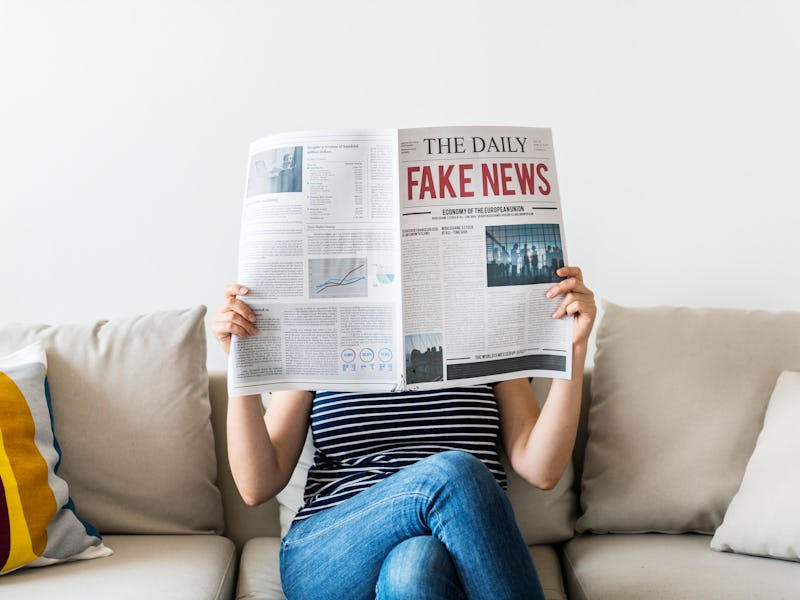Fact-checking is important. But it doesn't reach the people who need it
As hard as they tried, fact-checkers weren't able to defeat fake news in 2016 and probably won't in 2020.

The 2016 election will forever be associated with two words: fake news. Disinformation flooded social media feeds around the country, often working to elect now-President Trump. While the disinformation, and its backers within the Russian government, have been the subject of much hand-wringing, a new study throws cold water on one of the most touted weapons against the lies: fact-checking.
The study, published in Nature Human Behavior on Monday, looks at the results of a YouGov Pulse survey that included responses from over 2,500 Americans, which was conducted shortly before and shortly after the 2016 election. The survey attempted to determine how many people were getting their news from "dubious and unreliable websites." The researchers claim that the results of this survey show less than half of Americans were visiting these types of websites at that time.
"The reason that fact-checking doesn't work is because it's being done totally in the dark."
The more surprising figure is that these untrustworthy websites only accounted for 6 percent of what Americans were reading for news at the time. Conservatives accounted for 5 percent of that and liberals accounted for the remaining 1 percent. Around 57 percent of Trump supporters visited these kinds of websites, while only 28 percent of Clinton supporters did.
"Consistent with theories of selective exposure, people differentially consume false information that reinforces their political views," the study reads. "However, fewer than half of all Americans visited these untrustworthy websites."
The researchers argue that their results show that fake news wasn't as widely consumed in 2016 as people think it was. In terms of fact-checking, the study finds only 44 percent of people who visited untrustworthy websites in 2016 also visited fact-checking websites, so a majority of those who were consuming fake news were not checking to see if it was fake.
Brooke Binkowski, managing editor of the fact-checking website Truth or Fiction and a disinformation expert, tells Inverse that the study shows something she's found to be true, which is that people look for news that reinforces what they already believe. She said social media websites like Facebook make this problem worse by targeting people of certain political beliefs and feeding them content that will reinforce those beliefs.
"It is weapons-grade disinformation," Binkowski says. "The reason that fact-checking doesn't work is because it's being done totally in the dark. It's all opaque, and we can only rely on metrics from social media networks to tell us whether the stories are moving or not."
Though the study makes some good points about how much fake news people were actually reading, Binkowski points out that that doesn't mean fake news wasn't influencing people on a larger scale than what was found. She says a lot of people read a headline and share it without clicking the link, and then, of course, there are the memes on social media that contain false information that were shared widely in 2016.
Facebook has repeatedly claimed its committed to doing better in 2020 than it did in 2016 when it comes to fighting the spread of disinformation, but Binkowski isn't confident in the company's efforts. She says the social media giant is "still engaging in the exact behaviors that made the 2016 U.S. presidential election so awful."
See also: Facebook's latest attempt to fight misinformation is a sham, critics say
"But we have to keep trying. If we let the disinformation purveyors just push bullshit, it's going to get even worse," Binkowski says. "Disinformation — targeted and corrosive — has already pushed countries into ultraviolence. Look at India just last week. That was brought in on a wave of nationalistic trash, rolled along in a jingoistic fervor ignited and fed by disinformation on WhatsApp. Which — as its owner Facebook knows — is ephemeral."
Luckily, investigations into Russian election interference have made Americans more aware of the fact people are trying to influence them with disinformation. That said, a Pew survey that was released last month found both Democrats and Republicans expect fake news to be mostly used against their side, so tribalism may allow election interference to be successful again. As Binkowksi said, we have to keep trying to fight it anyway.
Abstract: Although commentators frequently warn about echo chambers, little is known about the volume or slant of political misinformation that people consume online, the effects of social media and fact checking on exposure, or the effects of political misinformation on behaviour. Here, we evaluate these questions for websites that publish factually dubious content, which is often described as fake news. Survey and web-traffic data from the 2016 US presidential campaign show that supporters of Donald Trump were most likely to visit these websites, which often spread through Facebook. However, these websites made up a small share of people’s information diets on average and were largely consumed by a subset of Americans with strong preferences for pro-attitudinal information. These results suggest that the widespread speculation about the prevalence of exposure to untrustworthy websites has been overstated.